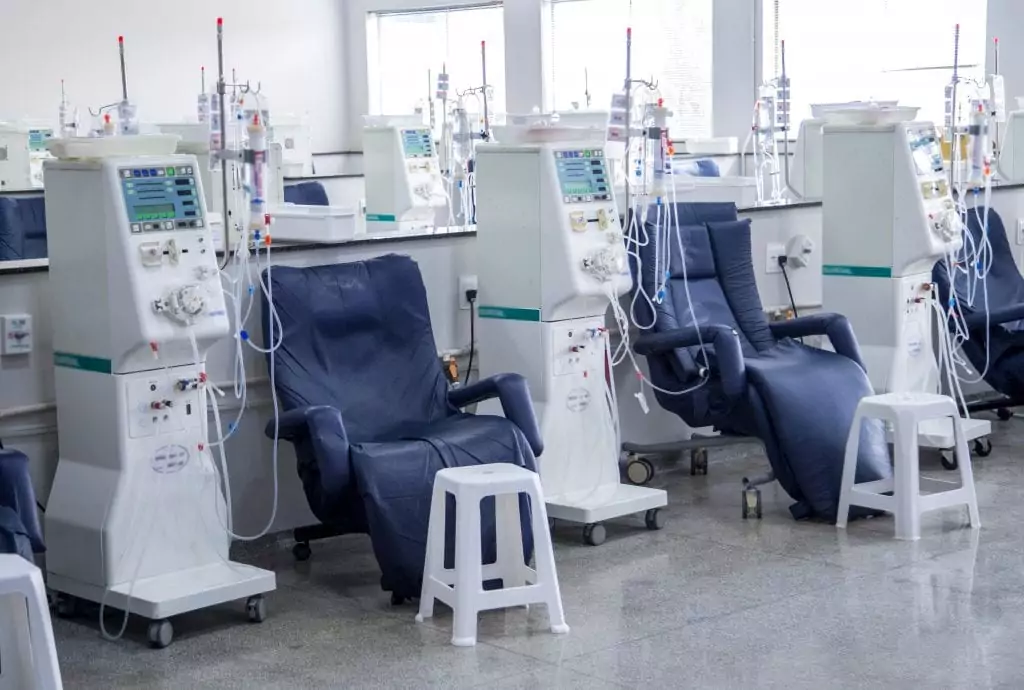What Are the Five Stages of Kidney Disease?
If you’re newly diagnosed with chronic kidney disease (CKD), you may already know that there are five progressive stages, and related symptoms increase in severity along with the stage. You may not know, though, the ins and outs of each stage and what each stage means for you in a practical sense. So, what are the five stages of chronic kidney disease?
How are the five stages of kidney disease determined?
The first thing to understand is how kidney disease, or renal disease, stages are determined. Kidney health is primarily measured by an estimated glomerular filtration rate (eGFR). Your GFR is the rate at which fluid is filtered through the kidneys. A higher filtration rate indicates a healthy kidney. A lower rate indicates reduced or suboptimal kidney function, whether due to disease or injury.
Your kidneys’ filtration rate is estimated by the amount of creatinine (cree-AT-uh-neen) in your bloodstream. Creatinine is a waste product that occurs when your body metabolizes creatine phosphate—a crystalline compound that your body creates from everyday muscle movement.
The kidneys filter creatinine out of the bloodstream. A serum test will show how much creatinine is in your blood. The higher the level of creatinine, the less of it your kidneys are filtering out. This test is key to estimating your level of kidney function.
What are the five stages of CKD based on your GFR?
Now that you know how the stages of CKD are determined, how does your GFR factor into each stage?
Stage 1
In stage 1 CKD, your GFR is 90 or above, meaning that your kidneys are functioning at 90% or better. Your filtration rate is normal, but there might be other indications that all is not well with your kidneys, such as the presence of proteins in your urine.
Stage 2
In chronic kidney disease stage 2, your GFR is between 60 and 89. Your filtration rate is slightly sub-par, and there may be other indications of inadequate kidney function. You are still largely asymptomatic, however, in terms of observable changes. There are several tests your physician can administer to determine your degree of kidney damage and the cause of lower kidney function, including blood and urine tests, an ultrasound, and a CT scan.
At this stage, it’s important to pay attention to your lifestyle habits, particularly diet and exercise. They play a crucial part in determining how fast the disease progresses.
Experts recommend that you:
- Get your blood sugar and blood pressure checked.
- Eat a healthy diet low in salt, sugar, and processed grains.
- Exercise at least five days a week for a minimum of 30 minutes per day.
- Quit all forms of smoking and tobacco use.
Stage 3
In stage 3 CKD, your GFR is between 30 and 59. At this stage, kidney disease can only be identified with a blood test. Stage 3 is often broken down into two phases: Stage 3a (early), during which your eGFR is between 45 and 59, and Stage 3b (late), during which your eGFR is between 30 and 44. During Stage 3, you may or may not be symptomatic.
If symptoms do appear, they are more likely to do so during Stage 3b and may include:
- Back pain
- Swollen hands and/or feet
- Unusually frequent or infrequent urination
As kidney function decreases, and wastes build up in your body, other adverse health conditions may develop, such as:
- High blood pressure
- Anemia
- Bone disease
Stage 3 is a good time to consult a nephrologist (kidney specialist) to devise and implement a treatment plan. Treatment for CKD focuses on preventing disease progression, specifically managing conditions that can complicate, or result from, the disease.
In addition to the conditions mentioned above, these can also include:
- Diabetes,
- Swelling
- High cholesterol
A treatment plan for CKD usually involves a combination of diet changes, adjustments in exercise frequency and intensity, and both prescribed medications and dietary supplements.
Stay ahead of your CKD
Responsum for CKD empowers people with kidney disease through community, knowledge, and shared experiences
Stage 4
In stage 4 kidney disease, your GFR is between 15 and 29. By now, you should be making regular visits to your nephrologist and maintaining your treatment plan. In this stage, you and your doctor should begin discussing your options in the event of kidney failure. There are two basic options at this point—dialysis or a kidney transplant.
There are two types of dialysis: hemodialysis and peritoneal dialysis:
- Hemodialysis is generally done in a medical environment and involves the use of a machine. Your blood flows into the machine, the machine cleanses it of impurities, and the clean blood is returned to your body.
- Peritoneal dialysis is generally done at home and involves the introduction of a cleansing agent through a catheter into the lining of your abdomen. The preparation for peritoneal dialysis requires minor surgery for the insertion of the catheter.
A kidney transplant has pros and cons. A new, working kidney filters waste from the blood more efficiently than dialysis. Patients can wait for years, however, before an appropriate donor becomes available. Moreover, not every patient with kidney failure is a good candidate for a transplant.
Your age, cognitive status, and other health conditions may make you ineligible for a kidney transplant. It’s important to keep in mind that, even if you’re approved for a transplant and a kidney is available, a transplant is not a cure. You’ll still need to take medications daily to ensure your immune system doesn’t reject the new kidney.
Stage 5
In stage 5, your GFR is less than 15, and your body is either about to go into kidney failure or is in kidney failure. This stage of the disease is also called end-stage kidney disease (ESKD) and end-stage renal disease (ESRD). Without functioning kidneys, waste products that have been collecting in your bloodstream reach toxic levels.
Some symptoms of kidney failure include those associated with Stage 3 (see above), in addition to:
- Diminished appetite
- Muscle cramps
- Itching
- Disturbed sleep
- Breathing trouble
- Nausea
- Vomiting
Stage 5 is the point at which you must either begin dialysis or receive a kidney transplant—but you are not alone on this journey. Nearly 750,000 people in the U.S. (and 2 million people worldwide) navigate stage 5 kidney disease every year. Many people with CKD live enjoyable, productive lives, whether on dialysis or post-transplant. While life expectancy tends to be longer with a transplant, some patients on dialysis have been known to live up to 20 or 30 years after having started treatment.



